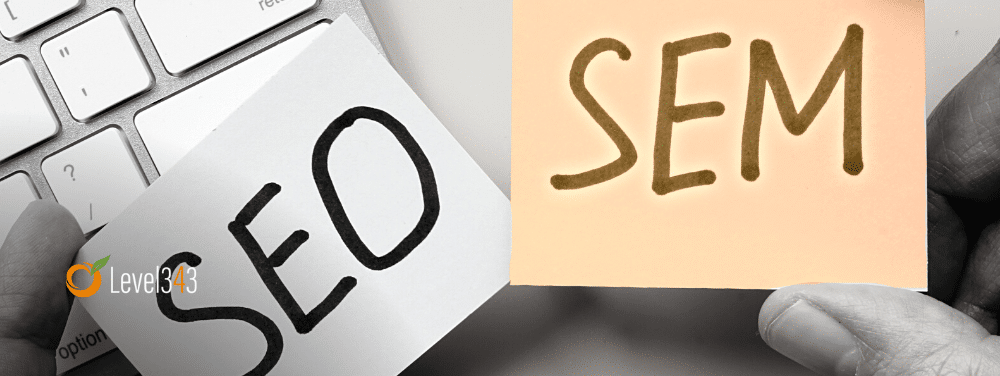Editor’s Note: This article is a combination of several articles that we’ve updated to be more current with today’s marketing styles, SEO guidelines and Google standards.
SEO (Search Engine Optimization) and SEM (Search Engine Marketing) are often confused because they both deal with digital marketing and improving a website’s visibility online. SEM and SEO aren’t the same thing, so what’s the difference between Search Engine Marketing and Search Engine Optimization?
While SEO is a subset of SEM, the two terms are not interchangeable.
SEO focuses on optimizing a website so that it ranks higher in search engine results pages (SERPs). Some of the strategies include on-page optimization, such as selecting the right keywords and using them throughout the website content, as well as off-page SEO tactics like link building and local SEO.. SEO is a long-term strategy that helps to improve organic traffic levels over time.
SEM, on the other hand, is a short-term strategy that focuses on paid advertising to improve a website’s visibility in SERPs. SEM campaigns can drive targeted traffic to a website quickly, but the campaigns typically require ongoing spending to maintain results. When done correctly, SEO and SEM can complement each other to create a holistic digital marketing strategy. SEM that includes SEO is the only path to success; end of discussion. Let’s look at some of the other strategies included in SEM and then weigh the pros and cons of not incorporating SEO.
SEM: Paid Inclusion, Pay-Per-Click, Paid Advertisements
One of the quickest ways to increase visibility and boost traffic is to use one of three successful strategies. Each one caters to the search engine by paying them to show your website.
Paid Inclusion
With the first strategy, paid inclusion, you pay search engines to list your website. For some search engines this is the only way to get listed. Others simply present it as an option, hoping that you’ll pay them instead of using other strategies – like hiring SEO services.
Pay-Per-Click
The second strategy, Pay-Per-Click and the third strategy,Paid Advertisements, are similar. Pay-Per-Click uses keywords; the price is figured by number of visits to a site through each link (i.e. pay-per-click) and the popularity of your chosen keywords.
Paid Advertisements
The third strategy, paid advertisements, is more traditional, posting information about a website or a company and then figuring the cost by number of ads, successful or not.
Both pay-per-click and paid advertisements entail paying for an advertisement of your website and both immediately send out information about your company on the search engines.
Advantages And Disadvantages of Other SEM Strategies
Immediacy is one of the major advantages of the strategies outlined above. As soon as you implement these strategies, they begin to bring attention to the website. You post the ad, and the website is listed. You “pay to play” and you are listed on the search engines. Your visibility is immediately increased and your traffic is boosted.
But then what? What happens if people visit your website and there’s nothing there of interest or help? What if you don’t have a fully functional website yet, but have all the tools for traffic to come? The disadvantage to these strategies is they are built for speed, not long-term sustainability. You need to add something else.
Advantages Of SEO
SEO used to be a strategy that businesses could eventually implement. This is no longer an optional component of online success, and is now an essential part of any comprehensive digital marketing strategy. Why? In 2020, retail e-commerce sales translated to $USD 8.1 trillion in world-wide sales. SEO is now an essential priority for any business who wants to remain competitive in the online space.
SEO drives traffic to your website, and the higher your traffic, the more leads you’ll generate. And the more leads you generate, the more sales conversions you’ll make. In other words, SEO has a direct impact on your ROI. The sooner you start investing in SEO, the sooner you’ll see a return on your investment. And remember, time equals money.
SEO And ROI
A surprising number of people have misconceptions about what an SEO provider does, and many of these questions deal with the cost, the time, what’s involved and the results. I see a great many specific questions about the practice, SEO providers and does SEO provide a return on investment (ROI)?The main question, as with most products and services, is “What’s it cost?”
SEO is not instantaneous. There is no magic “code”, rather, it is a process. While it’d be nice to think that you can dip into your source code, slap a couple of keywords into the meta tags and call it done, that’s not reality. Reality is much more complicated.
Time Equals Money
With many online services, such as website design, development and programming, an investment can yield quick visible results. At any time, a business owner can see the results of a web design, and there are tangible results for the time and cost that goes into the design.
In contrast, an SEO provider, can’t show immediate results as visibly – or as meaningfully – as a website designer. We can’t say, “Look, we messed with your source code”, but if you have no programmer and no technical knowledge, you can only take our word for it. What we can say, “We found such, such and such a keyword to be best for your site”, but again, you can only take our word for it. We can show you articles and blogs we have written and submitted to various sites, but they may not give you a dramatic increase in traffic.
In addition, many people understand that design, or “art”, is a talent – not everyone can do it. Those same people underestimate the power of strong writing. After all, writing is something necessary that everyone learns to do, so how hard can it be, forgetting that there is a fundamental difference between writing and writing well.
The Invisible Hero SEO
Now, all of this SEO “stuff” takes time; optimization is a process, especially for new sites. That time translates to cost, and depending on how much needs to be done, it can add up quickly. If you run across an SEO provider offering a full SEO package for $300, including full site optimization, keyword and competition research, site submission, directory submission, blog posts, articles, press releases and more – they either have entirely too much time on their hands or you won’t get the results you expect.
True optimization is not free; it’s time consuming and ongoing. It’s not a “set it and forget it” type of thing. It takes time to find the precise combination that hits the right notes.
Now, while you may say: “but I can search the Internet and get all the information to do it myself,” consider this:
- With all the contradictory information out there about optimization, how do you make sure you’re doing it right?
- How much time do you really have to do it right, and what could you be investing that time in instead?
- Can you afford to spend all the time necessary following the SEO information on the Internet (because time is money), only to get no results (or bad results) because you followed bad advice?
What is Better SEM-SEO-PPC
So, which of these three strategies is the best? The answer depends on your business goals and objectives. SEM and PPC can be very effective in generating leads and driving traffic to your website, but they can be expensive and time-consuming. SEO, on the other hand, is a more long-term strategy that can help you build an organic following and improve your visibility in search engine results pages over time.
Ultimately, the best digital marketing strategy for your business will depend on your specific goals and budget.
SEM
Search Engine Marketing has everything to do with marketing and very little to do with search engines and is the first of the power trio. SEM is the one we all see in action, although not many of us recognize it consciously. Those who perform SEM creating marketing campaigns just as they would for a physical store.
SEM has two purposes: to get your brand noticed and to make your products enticing. SEM professionals have a variety of tools in their marketing chest, from pay-per-click ads to social media, optimization to advertisements, videos to white papers. The particular combination depends on the business and the SEM professional’s skillset.
SEO
We’ve talked about SEO, but there is another layer to add, Semantic SEO. Semantic SEO considers not only the individual keywords of a search, but also the context of the search query. It’s an emerging trend that is quickly gaining traction about webmasters and search engine optimizers.
Semantic SEO can make your website more relevant to search engines and users. This allows for a more nuanced and accurate understanding of the user’s intent. (A cookie means very different things to a baker and an IT person, after all.) As a result, Semantic SEO can help you to improve your website’s ranking in the search results and drive more traffic to your site. Semantic SEO is an important tool for any webmaster or SEO who wants to stay ahead of the curve.
SEO, and increasingly, Semantic SEO remains one of the top ways to get Google Ranking. Optimization is not about making the search engine see you as a site relevant to the search term, although many people see it as that. Optimization is about making the engine see you as one of the top relevant sites.
PPC
Pay-Per-Click links are clickable ads leading to your chosen link. PPC rounds things off nicely. Used correctly and well researched, PPC can and will send clicks to your website. Those searching for goods, services or whatever else is covered by the ad will be led to that link (usually a landing page of some sort).
A strong PPC professional, knowledgeable in writing short ads, finding strong keywords and good placement, can make a lot of difference in the quality of hits. What keywords, ad placement and the length of text allowed for the ads all depend on how big your marketing budget is and what you want to achieve.
The Triad in Marketing
SEM, SEO and PPC work together to make the perfect online marketing campaign. The right professionals can create a knock-out marketing strategy, one planned to bring people to your website who are already interested in your product. They’re not just “looking around”.
SEM is the beginning of the strategy. SEM says “This is what we have to do to interest people in your company and your product.”
SEO is the second component of the “targeted” marketing strategy, which includes everything from your website design (is it compliant? Did you use good practices?) to your content quality (is it well-written? Are keywords used? Is it relevant?).
PPC is a combination of ad placement/writing and SEO content in the form of landing pages. A well-written, well-placed ad, combined with matching (and well-written) landing page content, has almost doubled a site owner’s ROI in some cases.
Combined, SEM, SEO and PPC will raise the number of clicks to your website, your Google placement (ranking) and your website quality. The rest is up to your product.




































4 Responses
I love using SEO to drive more traffic to my blogs and websites. I’ve noticed a big downturn in social shares and traffic as it’s becoming more and more fragmented. SEO brings in about 90% of my traffic now. I need to refine it though to get more sales and leads from it. Thanks for the info here!
Just keep asking the right questions… that’s been working for our B2B and B2C. As a matter of fact, I have a mini novella coming out next week 🫣 I’ve been trying to write this article for a few months. It’s not easy given psychology is never an easy thing to explain. User intent, how people search, etc. clients either shrug or get it, there’s no in between!
Thanks for the post and great overview.